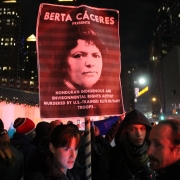Houston Agrees to $2 Billion Sewer Fix
The largest city in Texas is the latest to face a federal order to plug a leaky sewer system. Fewer such orders may be coming.

A storm sewer drain cover in Houston. Houston has separate storm and sanitary sewers. The sanitary sewers face a federal consent decree. Photo courtesy of Flickr/Creative Commons user Cheap Gear Guy
By Brett Walton, Circle of Blue
The City of Houston and the federal government have finalized a 15-year, $2 billion consent decree to curb the discharge of sewage into local waterways. The agreement ends a lawsuit filed by the U.S. Environmental Protection Agency and the Texas Commission on Environmental Quality.
“Over the next 15 years, the City will fix aging wastewater lines and upgrade infrastructure,” said Erin Jones, a Houston Public Works spokesperson. “This will help Houston keep pace with the growing population and provide better service to the community.”
Houston is one of dozens of medium- and large-sized cities, including Atlanta, Indianapolis, Kansas City, Seattle, Scranton, and Toledo, to sign a federal consent decree aimed at upholding the water quality goals of the Clean Water Act. It may also be one of the last, at least in the near term, to enter into one of these agreements. The EPA, after concentrating enforcement actions on sewage overflows for more than two decades, says that the most severe problems have been addressed. The agency indicated that it will remove municipal sewage and stormwater from its enforcement priority list next year and focus on a more collaborative approach.
Houston’s sewer system is one of the nation’s largest, with more than 6,000 miles of sewer mains, 390 lift stations, and 39 treatment plants that serve about 2 million people. The system is expansive but vulnerable, especially in a humid region where downpours are increasingly common. A storm that dumped more than 3 inches on April 17, 2015, led to a surge of water into the Greenridge treatment plant. Untreated solids mixed with treated water and resulted in a violation of the plant’s discharge permit.
Greenridge and other facilities will be getting a facelift in order to be better prepared to handle those situations. The consent decree targets three major components of the sewer system: lift stations that move sewage across the city’s relatively flat topography, pressurized sewer mains, and 10 of the city’s treatment plants. Remedial measures include a program to chip away at the pipe-blocking buildup of fats, oils, and grease, and an assessment of the system’s flow capacity. The goal, according to the consent decree, is to eliminate overflows from the sanitary sewer system and to eliminate or treat all discharges from three facilities that hold stormwater.
As in other cities, achieving that goal will not be cheap. Consent decrees generally result in repair bills that run into the hundreds of millions to billions of dollars. The Metropolitan Sewer District of St. Louis, for instance, signed an agreement in 2012 that stipulated at least $4.7 billion in modifications to its sewer system.
As a result of the consent decrees, sewer rates often soar to pay for new pipes, expanded treatment capacity, and underground reservoirs to hold runoff during a storm. That will be the case in Houston, too, where the cost of the projects will be shouldered by residents and businesses. Houston Public Works is reassessing its rates and expects them to rise in April 2020.
The Houston City Council is in favor of the agreement, voting on July 23 to approve the consent decree, with only one of 16 councilmembers opposed. The consent decree includes $4.4 million in civil penalties.
The rate increases that are required to pay for these projects contribute to growing concerns about the affordability of water and sewer service. Affordability is an acute anxiety for the poorest households. Houston officials say that their rate increase will not cause the average bill to rise above 2 percent of the service area’s median household income, a threshold used by the EPA for gauging affordability.
It’s a misleading claim. The EPA metric — 2 percent of median household income — is an indicator whether infrastructure projects might be too costly for the utility and the community as a whole. It is silent on whether rate increases will be a burden for specific ratepayers. A coalition of water industry groups suggested in April that the EPA modify its affordability criteria. They, like other researchers, recommended looking at households in the bottom fifth of the income distribution. These families are most likely to find rising rates unaffordable.
When asked whether its rate analysis would look at affordability beyond median household income, Jones of Houston Public Works said that it would.
Enforcement Changes
Rate increases in cities with consent decrees will persist. The coming years, however, may see fewer Clean Water Act consent decrees that target urban sewer systems, said Nathan Gardner-Andrews of the National Association of Clean Water Agencies, the group that advocates for sewage utilities.
That’s because the EPA has removed municipal sewage from its list of enforcement priorities starting next year.
“The expectation among the public wastewater sector is that enforcement is not going away — egregious cases will still be dealt with. But I don’t think we’re going to see the same level of focus [on consent decrees] because the agency feels that communities are on the right track,” Gardner-Andrews told Circle of Blue.
The EPA argues that the worst cases of sewage and stormwater pollution have been addressed. The agency has assessed and taken action at 97 percent of large combined sewer systems and 92 percent of large sanitary sewer systems. “Taken action” means that the agency has used consent decrees, civil lawsuits, or changes in permit requirements, said Michael Abboud, an EPA spokesperson. Those instruments will be monitored and evaluated for any necessary changes.
“EPA and states will continue to monitor implementation of the existing [combine sewer overflow], [sanitary sewer overflow], and stormwater long-term consent decrees and orders, and to adapt them to changing circumstances and new information, such as the increasing commitment of cities to implement green infrastructure, changes in financial capability, or technological advances,” Abboud wrote to Circle of Blue.
The photo caption for this story was updated to make it clear that the consent decree concerns the sanitary sewer system, not the storm sewer system.
Brett writes about agriculture, energy, infrastructure, and the politics and economics of water in the United States. He also writes the Federal Water Tap, Circle of Blue’s weekly digest of U.S. government water news. He is the winner of two Society of Environmental Journalists reporting awards, one of the top honors in American environmental journalism: first place for explanatory reporting for a series on septic system pollution in the United States(2016) and third place for beat reporting in a small market (2014). He received the Sierra Club’s Distinguished Service Award in 2018. Brett lives in Seattle, where he hikes the mountains and bakes pies. Contact Brett Walton












Dear photo editor, the image of a storm sewer is misleading. The consent decree is about improvements to sanitary sewers which carry sanitary wastewater and some stormwater that inadvertently enters the system through leaks and breakages.